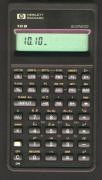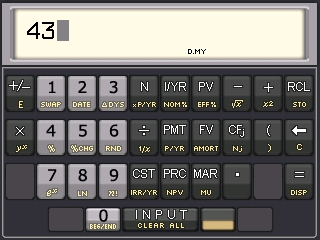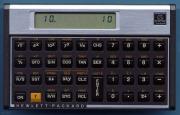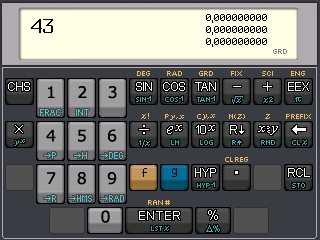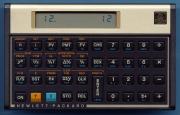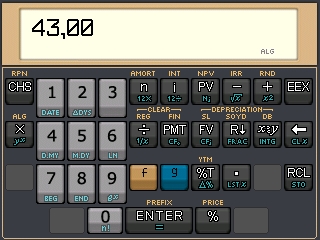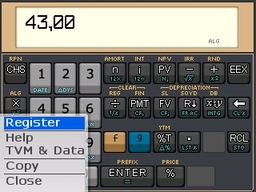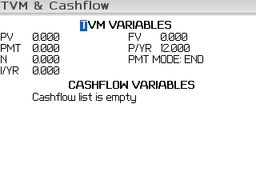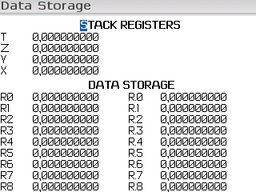Review: HP pocket emulator applications by Lygea Calculators
[rating:6.8] 6.8/10
Cost: $ 12.95 each
Pocket 10B SE Business Calculator for BlackBerry v1.10
Pocket 10C SE Scientific Calculator v1.0
Pocket 12C SE Financial Calculator for BlackBerry v1.0
On the first day of this series, I’ll present three calculators already. One of the first things I ran into while hunting calculators apps in the BerryReview store was this line of Hewlett-Packard pocket calculator emulators by Lygea Calculators. They are supposed to emulate more or less the same look and function of three classic HP models: the 10B, the 10C and the 12C. They all have very specific functions that might matter to certain students or professionals, but they still share enough similarities for me to lump them all together in one single group.
THE 10B “BUSINESS” CALCULATOR
The 10B (“B” as in “Business”) is the one that looks the least like its physical counterpart. Click the picture to see it in full size. The real 10B had a vertical layout that had to be adapted to the Blackberry Curve’s horizontal screen. Even on a Blackberry Pearl, the layout has to change a little because the screen is too small to fit all the keys and functions. So I guess many functions had to be sacrificed and it’s very hard for me to tell which ones because I am not familiar at all with this calculator. All I can say about it is from the point of view of someone who is just looking for a better calculator.
My first impression was excellent. Whatever hang-ups I have with the Blackberry calculator do not apply to this HP 10B emulator. This one really looks and feels like a calculator and I think I could actually have fun punching numbers into it. I was surprised because it displays the whole operation/expression in the display. For example, you key in 22*16+4*2 and this whole expression will be displayed in one single line until you hit Enter/Equals and get the result of the operation. I found that very pleasant visually. I get to see whatever is actually being calculated. There is one problem, though: precedence. This calculator does not apply any precedence to the operations so 22*16+4*2 equals 712 when you probably expect 360. If you want precedence (who doesn’t?), you’ll have to enclose the operations in parentheses: (22*16)+(4*2). Then you’ll get 360. That kind of put me off. It’s just not the right thing to do in an expression. Another problem is the equals sign is tucked in the corner of the layout. That may not seem a big deal at first, but it does get annoying after a while. That corner is too far.
This business calculator probably supports a lot of functions I am not famliar with so I didn’t even bother testing them. I can only assume that at least the functions you can see in the keyboard/layout are fully supported. I will discuss the issues in relation to the manual and information later in this article. Meanwhile, you can check a summary of its functions here.
THE 10C SCIENTIFIC CALCULATOR
The 10C is a scientific calculator and it looks quite a lot like its physical counterpart. Click the picture to see it in full size. But once again, it looks like a few functions have been sacrificed, maybe because there was no room for all of them in the keyboard/layout or maybe because it was too difficult to implement them.
I couldn’t help comparing the 10C with the 10B. The 10C looks more “complete” to me, but probably only because I have a stronger identification with scientific calculations than with business calculations. I actually studied a little engineering in College, when I was a lot younger. In other words, this one supports many more functions I am familiar with instead of the many functions of the 10B that completely mystified me. It will depend a lot on what you do, what you need, what you want. Meanwhile, you can check a summary of its functions here.
Another important distinction of the 10C is the support to RPN, which helps a lot with the precedence problem. Who needs parentheses when you have RPN? On the other hand, RPN is all you have with the 10C. The algebraic mode is not supported. This is obviously not a calculator for ordinary citizens to calculate their gas, income tax or keep track of their expense at the supermarket. This calculator packs too many functions that only specialized people are likely to be interested in.
What pleased me most about the 10C was that I could finally use the Space key for the “equals” command. Well, not quite since it’s RPN only so it’s actually the “enter” command. All the same, I like it.
THE 12C FINANCIAL CALCULATOR
The original HP 12C enjoys stardom status among all pocket calculators. It’s still widely used in its physical form, apparently. The 12C emulator is a financial calculator that also looks quite a lot like its physical counterpart. Click the picture to see it in full size. Just like the 10C, it looks like a few functions have been sacrificed. But the 12C seems to pack even more functions than the 10B. I tried to check that carefully but it turned out it was confusing to me because I am not at all familiar with all those financial functions and operations. I decided that I am simply not qualified enough to judge unless I just look at her from the standpoint of a layman in search of a better calculator. There is a summary of the 12C functions here.
The 12C supports both algebraic and RPN modes, so it is prone to please a wider audience. Whichever you choose, it will be there after you close the application and launch it again. What will not be there, however, is the stack display if you switch from RPN to algebraic. Switch back to RPN and the stack will be gone, and enabling it again is a little annoying. But I guess most users will just pick algebraic or RPN and commit for life.
As a layman, I noticed that the 10B and the 12C both support very interesting date calculation functions that could be useful even to me and are not available in the 10C. But the 12C has more functions than the 10B, so it’s probably better. The funny thing about the 12C is that I fell in love with it and I don’t even know why. The most important differences of the 12C probably are the many financial functions that made this model so popular, but I know nothing about them. To me, the 12C just looked and felt slightly better than the other two. Besides, the 12C also uses the Space key for the “equals” command in algebraic mode and the “enter” command in RPN mode. You certainly can see that I really like that.
THE PROBLEMS
The one big, big problem with these HP emulators is how complex they are. Sure, you can use them for simple calculations and they look and feel great for that, but I doubt there are many people in this world who will take issue against the Blackberry calculator like I did. Most people will be 101% fine with the Blackberry calculator. Besides, these emulators can be dangerous in wrong hands. For example, I had to apply a little percentage calculation to an invoice I was making the other day and instead of my desktop calculators and the several manual maneuvers I usually resort to (like pencil and paper), I used my Blackberry HP emulators. The resulting calculation was wrong by a small but still relevant difference. Luckily, I smelled something fishy in those figures and double checked them with 3 other calculators. I probably did something wrong with the HP calculators because I can’t operate them properly. Even after I spotted the error, I still can’t figure out how to make the 12C calculate my invoice correctly. There’s always an error when I add the percentage.
If you’re going to buy one of these emulators, you probably want or need the complex functions, but how do you get to use them? There is no documentation. Each one of these emulators has a small Help screen that guides you through a few basic functions like switching from algebraic to RPN mode (it’s quite convoluted with the 10C) or increasing/reducing the number of decimal places. But that’s it. Not one single word on how to perform any of the many specialized functions that each one of these little beasts are packing, not even at the Lygea Calculators’ Web site. So I did some independent searching and finally could find the original 10B and 12C manuals in PDF. But it was not very easy and I still haven’t found the 10C manual. I think Lygea Calculators have painted themselves into a corner with that. In the absence of manuals, these calculators should appeal to no one but a very narrow niche where people (old people) already know how to use these calculators. But if you still use one of these and you’re a professional serious enough to carry it around, you might not want to leave it home and carry just an emulator in your Blackberry because of the missing functions. And the young new users won’t be able to use these emulators because the functions are not documented. Actually, I talked to a few eggheads before writing this review and more than one of them told me “forget these, get an HP 48 or HP 50 already” or words to that effect. The 10C, at least, is considered obsolete. Lygea Calculators also has a 15C emulator, and my research suggests that the 15C is still quite cherished by many scientists and engineers, but Lygea Calculators does not make the 15C for the Blackberry. 🙁
Another problem I saw with these emulators is that they don’t offer any “history” or “ticker tape” and I think that is especially important in business and finance situations. You can copy the result from the 10C and the 12C display to the clipboard, but that’s about it.
Last, but not least, there is no integrated conversion of measurements in any of these HP emulators. You can always look up the measurement values and calculate, but that’s not convenient by any standard.
Pros and cons: forget about it, let’s introduce a new comparison method for all of this week’s calculators:
Look and feel: 10 (a lot like the physical counterparts)
Ease of use: 7 (lack of documentation)
Math functions: 9 (or 10, maybe? They certainly can do a lot)
Data display: 8 (no full expression and no ticker tape)
Measurement conversion: 0 (not integrated)
Average: (10+7+9+8+0=34) / 5 = 6.8

